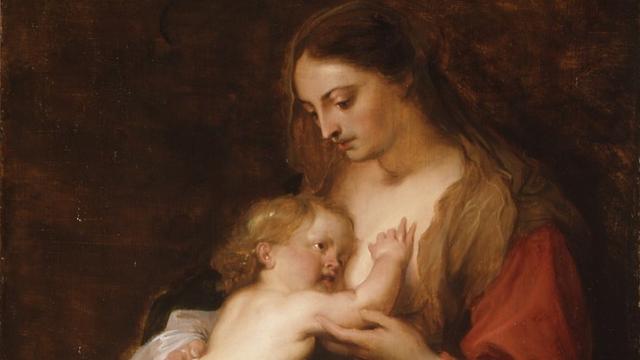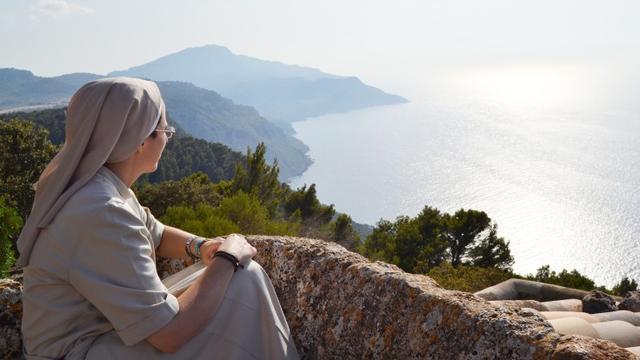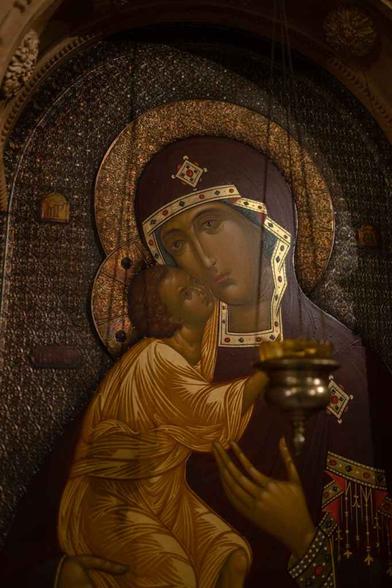Mariology
This is the Christian theological study of the Virgin Mary, mother of Jesus. Mariology looks to relate doctrine/dogma about Mary to other doctrine of the faith, like those concerning Jesus & notions about redemption, intercession, & grace.
Christian Mariology looks to place the role of the historic Mary in the context of Scripture, tradition, & the teachings of the Church of Mary. In terms of social history, Mariology may be broadly defined as the study of devotion to & thinking about Mary throughout the history of Christianity.
There’s a variety of Christian, & non-Christian, views on Mary as a figure ranging from the focus on the veneration of Mary in Roman Catholic Mariology to criticism of “mariolatry” as a form of idolatry.
As a field of theology, the most substantial developments in Mariology, & the founding of specific centers devoted to its study. In recent centuries, it’s taken place within the Roman Catholic Mariology.
The Eastern Orthodox ideas, & veneration, of Mary are integral to the rite as a whole (theotokos). They’re mostly expressed in liturgy. The veneration of Mary is said to permeate, in a way, the entire life of the Church as a “dimension” of dogma, as well as piety, of Christology as well as of Ecclesiology.
While similar to the Roman Catholic view, barring some minor differences, the Orthodox don’t see a need for a separate academic discipline of Mariology, as the Mother of God is seen as the self-evident apogee of God’s human creation. Apogee is the highest point in the development of something.
A significant number of Marian publications were written in the 20th century. Theologians Raimondo Spiazzi & Gabriel Roschini produced 2,500 & 900 publications respectively.
Over the centuries, Roman Catholic Mariology has been shaped by various forces ranging from sensus fidelium to Marian apparitions to the writing of saints to reflection by theologians & papal encyclicals. Encyclicals are papal letters sent to all bishops of the Roman Catholic Church.
Eastern Orthodox theology calls Mary “the Theotokos” or the God bearer. The virginal motherhood of Mary is at the center of Orthodox Mariology. The title of Ever Virgin is/was given to Mary. The Orthodox Mariology approach emphasizes the sublime holiness of Mary, her share in redemption, & her role as a mediator of grace.
Eastern Orthodox mariological thought goes back as far as St. John Damascene, who in the 8th century, wrote on the mediative role of Mary & one the Dormition of the Mother of God. Dormition is from the Latin “dormine” meaning to sleep. This is in reference to the death & subsequent assumption into Heaven to Mary, the mother of Jesus, in Eastern Christianity & some other churches.
In the 14th century, Orthodox Mariology began to flourish among Byzantine theologians who held a cosmic view of Mariology. This puts Jesus & Mary together at the center of the cosmos & saw them as the goal of world history.
More recently, the Eastern Orthodox Mariology achieved a renewal among 20th century theologians in Russia. Mary is the heart of the Church & the center of creation. Unlike the Catholic approach, Eastern Orthodox Mariology doesn’t support the Immaculate Conception Mary. Before the 20th century, Eastern Orthodox Mariology was almost entirely liturgical. It didn’t have any systematic presentation similar to Roman Catholic Mariology.
Protestant views on Mary differ between different denominations. Focus is generally on interpretations of Mary in the Bible, the Apostles’ Creed (which professes the Virgin Birth), & the Ecumenical Council of Ephesus in 431, which called Mary the Mother of God. Some early Protestants created Marian art & allowed limited forms of Marian veneration. Most Protestants today don’t share the veneration of Mary as practiced by Roman Catholics & Eastern Orthodox. Martin Luther, John Calvin, & Karl Barth’s views on Mary, & others have contributed to modern Protestant views.
Anglican Marian theology varies greatly from the Anglo-Catholic, which are very close to Roman Catholic views. The Anglican Church formally celebrates 6 Marian feast days: the Annunciation (March 25), Visitation (May 31), Day of Mary/Assumption or dormition (August 15), Nativity of Mary (September 8), Our Lady of Walsingham (October 15), & Mary’s Conception (December 8). Anglicans, with some other Protestants, teach the Marian dogmas of divine maternity & the virgin birth of Jesus. Even though there’s no systematic agreed upon Mariology among diverse parts of the Anglican Communion. The role of Mary as a mediator is accepted by some groups of modern Anglican theology.
Lutheran Mariology is informed by the Augsburg Confession & honors Mary as “the most blessed Mother of God, the most blessed Virgin Mary, & the Mother of Christ.” The Lutheran Churches, asserts the doctrine of the perpetual virginity of Mary.
The Oriental Orthodox Churches regard Mary as the highest of saints & the Theotokos. They also celebrated a variety of Marian feast days.
In the Islamic perception of the Virgin Mary (known as Maryam in Arabic), she’s an extremely pious & chaste woman who miraculously gave birth, while still a virgin, to the prophet Jesus (called Isa in Arabic). Mary is the only woman named specifically in the Quran. The 19th chapter of the Quran, which is named after her, begins with 2 narrations of a “miraculous birth.”
The First Council of Ephesus, in 431, formally approved devotion to Mary as the Theotokos. Its use implies that Jesus, whom Mary gave birth to, is God. Nestorians preferred Christotokos, meaning “Christ-bearer” or “Mother of the Messiah”, not because they denied Jesus’ divinity. But because they believed that since God the Son, or Logos, existed before time & before Mary. Jesus took divinity from God the Father & humanity from His mom. So calling her “Mother of God” was confusing & perhaps heretical. Others at the council believed that denying the Theotokos title would carry with it the implication that Jesus wasn’t divine.
The Council of Ephesus also approved the creation of icons having the images of the Virgin & child. Devotion to Mary was already widespread before this point. This is reflected in the fresco depictions of Mother & child win the Roman catacombs.
Mary, as the 1st Christian saint & Mother of Jesus, was deemed to be a compassionate mediator between suffering mankind & her son, Jesus, who’s seen as a king & judge.
In the East, devotion to Mary blossomed in the 6th century under official patronage & imperial promotion of the Court of Constantinople. The popularity of Mary as an individual object of devotion only became in the 5th century with the appearance of apocryphal versions of her life, interest in her relics, & the 1st churches dedicated in her name. Like St. Maria Maggiore in Rome.
Since the writing of the apocryphal Protoevangelium of James, various beliefs have circulated concerning Mary’s own conception. This led, eventually, to the Roman Catholic Church dogma. It was formally established in the 19th century of Mary’s Immaculate Conception. This exempts her from original sin. This story goes: When Mary’s mom got pregnant with her, it was an Immaculate Conception. So when Mary was born, she was free from original sin. After Mary was born, she was sent to the Temple to live, so she wouldn’t get corrupted by the world. So Mary could be pure to have Jesus.
Roman Catholic & Eastern Orthodox teaching also extends to the end of Mary’s life ending with the Assumption of Mary. This was formally established as dogma in 1950 & the Dormition of the Mother of God respectively.
One-Time Monthly Yearly
Make a one-time donation
Make a monthly donation
Make a yearly donation
Choose an amount
$1.00 $5.00 $10.00 $1.00 $5.00 $10.00 $5.00 $10.00 $15.00
Or enter a custom amount
$
Your contribution is appreciated.
Your contribution is appreciated.
Your contribution is appreciated.
DonateDonate monthlyDonate yearly
#19thCentury #20thCentury #431 #5thCentury #6thCentury #8thCentury #Anglican #AnglicanCommunion #Apocryphal #Apogee #ApostlesCreed #Arabic #Assumption #AssumptionOfMary #AugsburgConfession #August15 #bible #Bishops #Byzantine #ChristBearer #Christian #Christianity #Christotokos #Churches #CourtOfConstantinople #December8 #Dogma #Dormition #EasternOrthodox #Ecclesiology #EcumenicalCouncilOfEphesus #Encyclical #EverVirgin #FirstCouncilOfEphesus #GabrielRoschini #GodBearer #Idolatry #ImmaculateConception #Isa #Islam #Jesus #JohnCalvin #KarlBarth #King #Liturgy #Logos #Lutheran #March25 #Mariology #MartinLuther #MarySImmaculateConception #Maryam #May31 #MotherOfGod #MotherOfTheMessiah #Nativity #Nestorians #October15 #OrientalOrthodoxChurch #OriginalSin #Papal #PerpetualVirginityOfMary #Prophet #Protestant #Quran #RaimondoSpiazzi #relics #RomanCatholicChurch #Rome #Russia #Saint #Saints #SensusFidelium #September8 #StJohnDamascene #TheAnnunciation #TheProtoevangeliumOfJames #Theolgians #Theotokos #Veneration #VirginBirth #VirginMary #Walsingham





